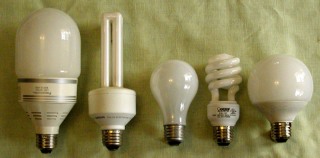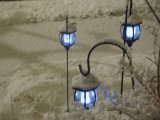Climate Change, Energy Conservation,
and Sustainability
Humans are changing the earth's climate by burning
fossil fuels and destroying forests. Polar regions have been
especially affected, threatening wildlife such as polar bears.
Melting of the Greenland and Antarctic ice sheets is causing the sea
level to rise, endangering islands and coastal areas. Warming of
the seas causes further sea level rise, and together with
acidification from dissolved CO2 it threatens marine species such as
coral. If we continue to burn increasing amounts of
fossil fuels, these changes will accelerate, causing severe damage to
human populations and the environment during the next fifty to one
hundred years. There is strong evidence the highest safely
sustainable level of atmospheric CO2 is 350 parts per million (ppm),
but earth is
already above that level. It is urgent to reduce CO2 emissions to
the lowest level possible before the effects become irreversible.

The only way that climate change can be slowed and eventually
stabilized or reversed is to drastically
reduce the amount of carbon dioxide and other greenhouse gases we
generate. Energy conservation is part of the answer, since we
currently use far more energy than necessary. Another part is to
move
from dependency to fossil fuels and other non-renewable resources to
sustainable alternatives.
BBC News reviews the evidence, the consequences, and the options in a report on climate change from
their Weather Centre.
The Union of Concerned Scientists web
site contains objective scientific information about global
warming, its causes and effects, and what can be done to minimize it.
Energy Conservation (revised July 25, 2013)
Each of us can take steps to reduce our energy consumption, thereby
reducing climate change. One simple thing is to look for Energy Star
labels on all light bulbs, appliances, computers, and even new homes. Another
is to purchase the most efficient automobiles available. These
are generally hybrids, although some conventional gasoline and diesel
models achieve EPA ratings in the 30s and 40s.
By far the easiest way to save energy is to replace incandescent light
bulbs with compact fluorescent lamps (CFLs), or better yet, LED (light
emitting diode) bulbs. CFLs which screw into
ordinary table lamps and fixtures are now available at most local
hardware stores and even grocery stores. They are more expensive
to purchase than incandescent lamps, but they last about 6 to 15 times
as long and use only 20% to 25% as much energy. LEDs use even
less electricty and last more than 25 times as long as incandescent
bulbs. Both CFLs and LEDs save far more money over their lifetime
than they cost initially -- think of them as light bulbs that give you
money back on your electric bill.
The big news is that LED bulb are now readily available, and the prices
have come way down. Home Depot generally has the best price and
selection, but Lowe's is a close second. For example, at Home
Depot a CREE 40-watt replacement LED bulb (which uses only 6 watts)
currently costs $9.97, while a Philips 60-watt equivalent LED costs
$10.97 and uses 10.5 watts (prices as of 7/25/2013).
When I replaced the incandescentc light bulbs in my home with CFLs, I
saved about 100 kilowatt hours per month. At $0.10 per kilowatt
hour,
that amounts to $10 per month or $120 per year. So over their
life of
about 5 years (10,000 hours), they saved me about $600. It has
been
estimated that if every household in the United States replaced just
one
light bulb with a compact fluorescent lamp, the electricity saved
would be equivalent to the output of a large nuclear power
station. Given that most of the energy would actually be produced
by fossil fuels, the EPA estimates that the carbon emissions avoided
would be equal to those of
almost 800,000 automobiles.
 All
the lamps in the picture at left put out approximately the same amount
of light, 800 to 890 lumens. The incandescent lamp in the center
uses 60 watts of power, the circa 1990 CFLs on the left (which I'm
still using in my home) use 15 watts, and the present-day CFLs on the
right use 13 to 14 watts. LED bulbs (not pictured) do even
better, producing the same amount of light for 9.5 to 12 watts.
Unlike CFLs, LEDs do not require any warm-up time and their life is not
shortened by being switched on and off frequently. Many LEDs are
also dimmable.
All
the lamps in the picture at left put out approximately the same amount
of light, 800 to 890 lumens. The incandescent lamp in the center
uses 60 watts of power, the circa 1990 CFLs on the left (which I'm
still using in my home) use 15 watts, and the present-day CFLs on the
right use 13 to 14 watts. LED bulbs (not pictured) do even
better, producing the same amount of light for 9.5 to 12 watts.
Unlike CFLs, LEDs do not require any warm-up time and their life is not
shortened by being switched on and off frequently. Many LEDs are
also dimmable.
Look for the Energy Star logo on CFLs and LEDs to make sure they meet certain
minimum standards.
Early CFLs were too bulky to fit in some
fixtures, and sometimes tended to flicker or produce greenish
light. All these problems have
been solved, as well as the "power factor" problem. Models are
readily available to fit almost anywhere an incandescent lamp is used,
including spotlights and outdoor floodlights. For outdoors, be
sure to use weatherproof lamps or enclosures. Bear in mind that
CFLs become noticeably dimmer below about 20 F (-7 C), though they can
function down to about -10 F or even -20 F (-23 to -29 C), but temperature is not a problem with LEDs.

Even very small LED lamps have their uses. I'm using one as a porch light, and find that it gives enough
light for the purpose even though it draws only 1.2 watts. Unlike most newer LEDs, the
light is bluish white (6000 K color temperature, similar to daylight or
moonlight), which matches our LED solar Christmas lights and
solar lanterns. (Click picture at right for a larger
image.)
 |
|
Solar powered yard lanterns are another way to
provide
light outdoors, and they generate their own electricity. I have
replaced the original nickel-cadmium AA batteries with nickel metal
hydride, and occasionally polish the plastic lenses of the solar cells
to keep them working efficiently.
|
Sustainability
We will always need sources of energy, even though we use them as
efficiently as possible. Sustainable or renewable energy sources
are those which have minimal impact on the environment and do not rely
on fossil fuel. Most of these derive energy from the sun, either
directly or indirectly (such as wind energy or biomass).
In the same way, some materials such as food and fibers from plants can
be produced sustainably. Buying food from local organic farms
saves energy used for transport and the production of agricultural
chemicals, while producing less pollution.
The Rocky Mountain Institute is a
research and consulting organization devoted to sustainability.
There is a wealth of information on their web site. Although some
of their ideas may seem visionary, most of them only require currently
available technology. For example, they have helped the
semiconductor industry save vast amounts of energy in chip fabs, mainly
by better design of ventilation systems in clean rooms.
Widespread use of sustainable energy will require extensive
infrastructure changes. These are already beginning, for example
with the construction of large-scale wind turbine installations, but
changes in government policy are needed to accelerate the
process. Other countries, such as Denmark and Germany, are far
ahead of the United States in sustainable energy generation.
Meanwhile, we can use sustainable energy on a small scale in our
homes. Electric generation by photovoltaic panels or small wind
generators can be stand-alone or tied in with the electric grid.
Passive or active solar heating is virtually free to operate once
constructed. It can be as simple as opening and closing the
curtains on our windows, or we can build sun spaces or collectors and
heat storage to produce most of our heat and hot water.
Further reading
Winning the Oil Endgame:
Innovation for Profits, Jobs, and Security,
by Amory B. Lovins et al (Rocky Mountain Institute 2005), ISBN
1-881071-10-3. This study, financed in part by the Pentagon,
shows how the United States can eliminate half of our oil use by the
year 2025, with a net savings of $70 billion per year.
How
to live a low-carbon life,
by Chris Goodall (Earthscan 2007), ISBN 978-1-84407-426-6. The
basic theme of this book is that is that individuals must act first to
voluntarily reduce their own greenhouse gas emissions before
corporations and governments will act, and that action is very urgent.
Goodall
has made a detailed study of the quantity of greenhouse gasses emitted
per person in the U.K. which shows that at least a 75% reduction is
needed to meet sustainable levels. The good news is that it is
possible for individuals to achieve these reductions today. U.S.
readers will find that most of his recommendations can be applied here
as well, but the necessary reductions may be larger.
Real Goods Solar Living Source Book (12th ed), by John
Schaeffer (Real Goods 2005), ISBN 0-916571-05-X (available from Solar Living Institute).
This is a unique blend of reference book and catalog, which teaches the
basics of sustainable construction, energy conservation and sustainable
power followed by catalog pages with multiple products in each
category.
As the name of the book implies, there is considerable
information on solar power generation, but also wind power,
mini-hydroelectric, hay-bale construction, composting toilets, and much
more. Whether or not you buy materials from Real Goods, this is
an informative and useful book.
<-Home
Last updated July 25, 2013


 All
the lamps in the picture at left put out approximately the same amount
of light, 800 to 890 lumens. The incandescent lamp in the center
uses 60 watts of power, the circa 1990 CFLs on the left (which I'm
still using in my home) use 15 watts, and the present-day CFLs on the
right use 13 to 14 watts. LED bulbs (not pictured) do even
better, producing the same amount of light for 9.5 to 12 watts.
Unlike CFLs, LEDs do not require any warm-up time and their life is not
shortened by being switched on and off frequently. Many LEDs are
also dimmable.
All
the lamps in the picture at left put out approximately the same amount
of light, 800 to 890 lumens. The incandescent lamp in the center
uses 60 watts of power, the circa 1990 CFLs on the left (which I'm
still using in my home) use 15 watts, and the present-day CFLs on the
right use 13 to 14 watts. LED bulbs (not pictured) do even
better, producing the same amount of light for 9.5 to 12 watts.
Unlike CFLs, LEDs do not require any warm-up time and their life is not
shortened by being switched on and off frequently. Many LEDs are
also dimmable.